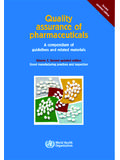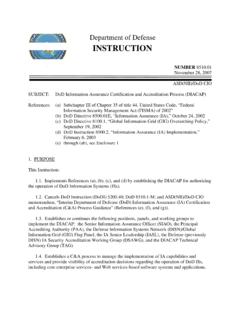Transcription of WHO good manufacturing practices for …
1 77 Annex 2 WHO good manufacturing practices for pharmaceutical products: main principles1 Introduction 79 General considerations 80 Glossary 81 Quality management in the medicines industry: philosophy and essential elements 851. pharmaceutical quality system 85 Quality risk management 88 Product quality review 882. good manufacturing practices for pharmaceutical products 903. Sanitation and hygiene 914. Qualification and validation 915. Complaints 926. Product recalls 937. Contract production, analysis and other activities 94 General 94 The contract giver 94 The contract acceptor 95 The contract 968.
2 Self-inspection, quality audits and suppliers audits and approval 97 Items for self-inspection 97 Self-inspection team 98 Frequency of self-inspection 98 Self-inspection report 98 Follow-up action 98 Quality audit 98 Suppliers audits and approval 981 The current document is a revision of WHO good manufacturing practices for pharmaceutical products: main principles, previously published in WHO Technical Report Series, No. 961, 2011, Annex Technical Report Series No. 986, 2014 WHO Expert Committee on Specifications for pharmaceutical Preparations Forty-eighth report9. Personnel 99 General 99 Key personnel 9910.
3 Training 10311. Personal hygiene 10312. Premises 104 General 104 Ancillary areas 105 Storage areas 106 Weighing areas 106 Production areas 107 Quality control areas 10813. Equipment 10814. Materials 109 General 110 Starting materials 110 Packaging materials 111 Intermediate and bulk products 112 Finished products 112 Rejected, recovered, reprocessed and reworked materials 112 Recalled products 113 Returned goods 113 Reagents and culture media 113 Reference standards 114 Waste materials 114 Miscellaneous 11515. Documentation 115 General 115 Documents required 11616. good practices in production 125 General 125 Prevention of cross-contamination and bacterial contamination during production 126 Processing operations 127 Packaging operations 12817.
4 good practices in quality control 129 Control of starting materials and intermediate, bulk and finished products 131 Test requirements 132 Batch record review 134 Stability studies 134 References 135 Annex 279 IntroductionThe first WHO draft text on good manufacturing practices (GMP) was prepared in 1967 by a group of consultants at the request of the Twentieth World Health Assembly (resolution ). It was subsequently submitted to the Twenty-first World Health Assembly under the title Draft requirements for good manufacturing practice in the manufacture and quality control of medicines and pharmaceutical specialities and was revised text was discussed by the WHO Expert Committee on Specifications for pharmaceutical Preparations in 1968 and published as an annex to its twenty-second report.
5 The text was then reproduced (with some revisions) in 1971 in the Supplement to the second edition of The International 1969, when the World Health Assembly recommended the first version of the WHO Certification Scheme on the quality of pharmaceutical products moving in international commerce in resolution , it accepted at the same time the GMP text as an integral part of the Scheme. Revised versions of both the Certification Scheme and the GMP text were adopted in 1975 by resolution Since then, the Certification Scheme has been extended to include the certification of: veterinary products administered to food-producing animals; starting materials for use in dosage forms, when they are subject to control by legislation in both the exporting Member State and the importing Member State; information on safety and efficacy (resolution , 1988).
6 In 1992, the revised draft requirements for GMP were presented in three parts, of which only parts 1 and 2 are reproduced in this document (1). Quality management in the medicines industry: philosophy and essential elements , outlines the general concepts of quality assurance (QA) as well as the principal components or subsystems of GMP, which are joint responsibilities of top management and of production and quality control management. These include hygiene, validation, self-inspection, personnel, premises, equipment, materials and documentation. good practices in production and quality control , provides guidance on actions to be taken separately by production and by quality control personnel for the implementation of the general principles of two parts were subsequently supplemented by further guidelines which are integral parts of these GMP for pharmaceutical products.
7 All these texts are available on the Medicines web page ( html).80 WHO Technical Report Series No. 986, 2014 WHO Expert Committee on Specifications for pharmaceutical Preparations Forty-eighth reportConsiderable developments in GMP have taken place in the intervening years, and important national and international documents, including new revisions, have appeared (2 5). Thus there is a necessity to revise the main principles and incorporate the concept of other items of feedback discussed during the consultation on WHO guidelines for medicines quality assurance, quality control (QC) laboratories and transfer of technology on 27 31 July 2009, the need was identified to incorporate a new section on Product quality review under Chapter 1: Quality assurance.
8 In addition, several updates were suggested to further enhance the guidelines. These included the concept of risk management, replacing drugs by the term medicines and introducing the concept of a quality unit .During 2012 the Secretariat was made aware that the current good manufacturing practices (GMP) for pharmaceutical products: main principles, published as Annex 3 in the WHO Technical Report Series, No. 961, 2011, would need updating ( Quality assurance of pharmaceuticals: a compendium of guidelines and related materials).The WHO Expert Committee on Specifications for pharmaceutical Preparations discussed the need for an update during its forty-seventh meeting and agreed to pursue the matter following sections were updated in the newly revised version and, after the usual consultation process, were presented to the forty-eighth Expert Committee for adoption:Section: pharmaceutical quality systemSection 2: 2.
9 good manufacturing practices for pharmaceutical productsSection 7: Contract production, analysis and other activitiesSection 17: 17. good practices in quality controlGeneral considerationsLicensed pharmaceutical products (marketing authorization) should be manufactured only by licensed manufacturers (holders of a manufacturing authorization) whose activities are regularly inspected by competent national authorities. This guide to GMP shall be used as a standard to justify GMP status, which constitutes one of the elements of the WHO Certification Scheme on the quality of pharmaceutical products moving in international commerce, through the assessment of applications for manufacturing authorizations and as a basis for the inspection of manufacturing facilities.
10 It may also be used as training material for government medicines inspectors, as well as for production, QC and QA personnel in the 281 The guide is applicable to operations for the manufacture of medicines in their finished dosage forms, including large-scale processes in hospitals and the preparation of supplies for use in clinical good practices outlined below are to be considered general guides,2 and they may be adapted to meet individual needs. The equivalence of alternative approaches to QA, however, should be validated. The guide as a whole does not cover safety aspects for the personnel engaged in manufacture, or environmental protection: these are normally governed by national legislation.














